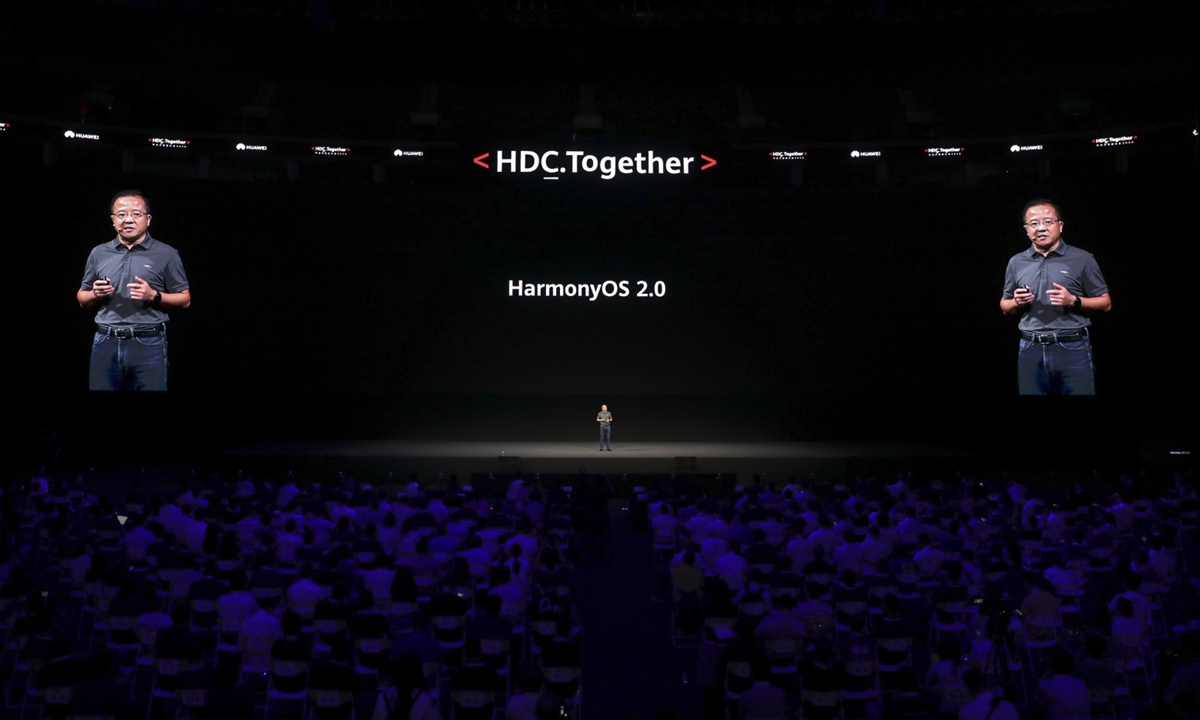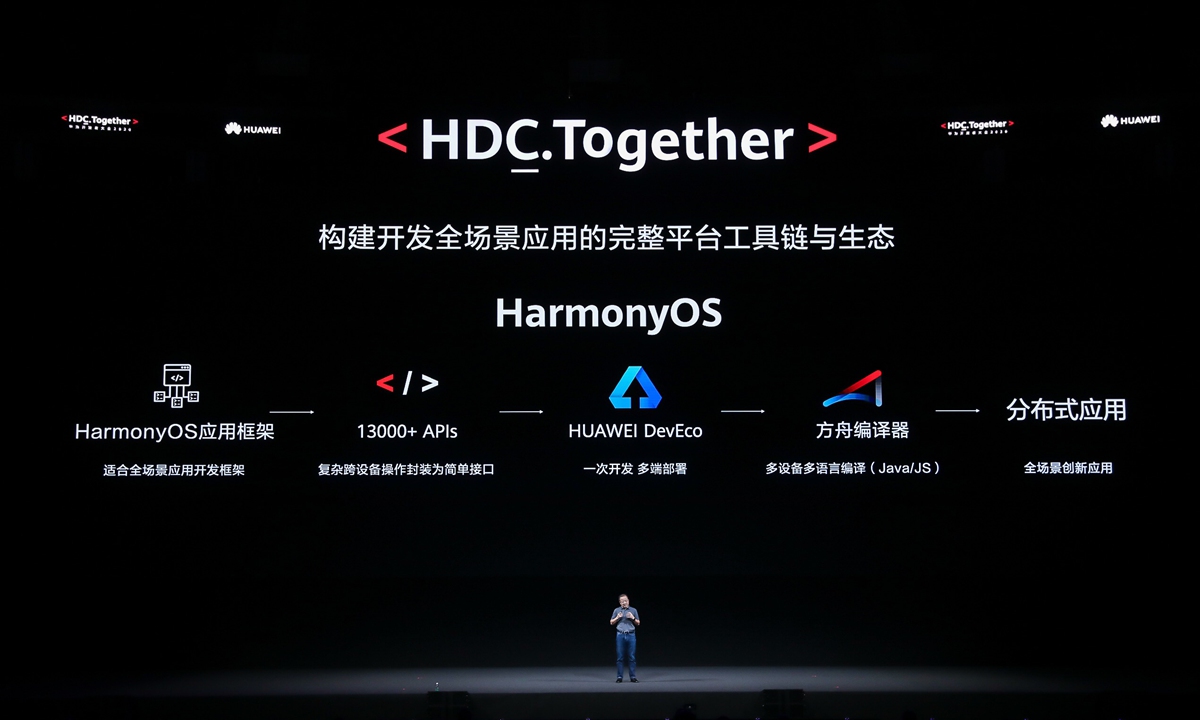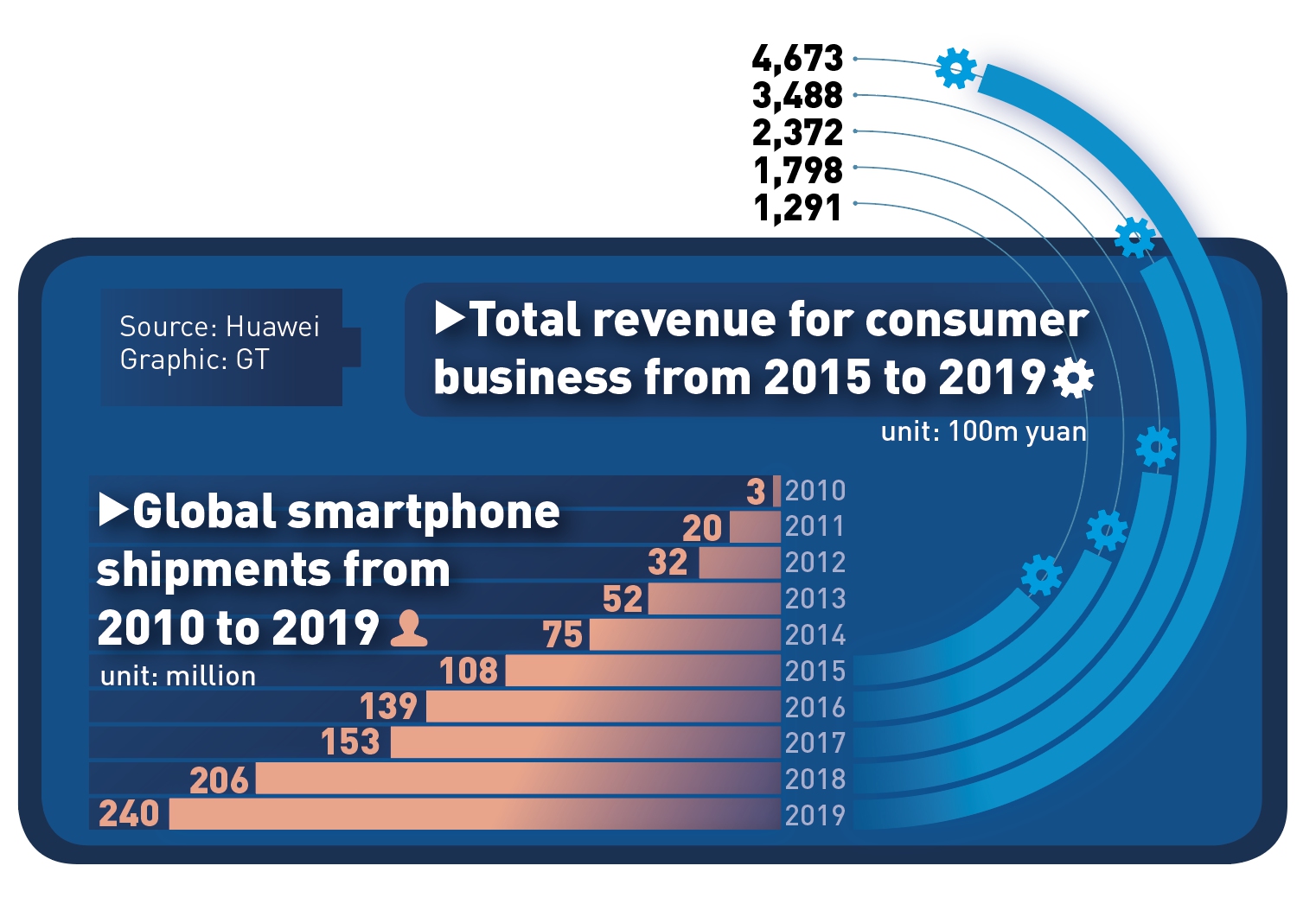

As deadline for cutting off chipset supply looms, Chinese tech giant takes further moves of reducing reliance on US technologies

Photo: Courtesy of Huawei
This might be one of the most difficult moments for Huawei, China's leading tech company that has been targeted by the US government for over a year. From cutting off chipset supply, restricting tech exports to arresting its senior executive, the US-initiated tech war against China has severely disrupted the global supply chain and led more industry representatives to take a deeper reflection on how to survive the crackdown and reduce reliance on US-made technologies.
On Thursday, Huawei gave its response to this tech war: open up to worldwide developers and build the third largest mobile ecosystem, after Apple's iOS and Google's Android.
"No pause, no stop. Let's play together" is the slogan for this year's Huawei Developers Conference 2020 (HDC2020), which kicked off on Thursday in Dongguan, South China's Guangdong Province.
The event came along as the US government issued a new rule in mid-August that would prevent Huawei from acquiring chips developed or produced with US technology and software, which is widely seen as a death threat to Huawei's high-end smartphone business.
The yearlong US ban also put the operating system of the Chinese firm in danger, as it could also cut Huawei from accessing Google's Android updates and security patches.
A series of development in Huawei's self-developed operating system HarmonyOS, EMUI 11 and its own ecosystem Huawei Mobile Services (HMS) Core 5.0, is all considered the Chinese tech giant's direct response to the expanded ban from the Trump administration as the tech cold war between the US and China heats up and poses a severe threat to the global supply chain, particularly as September 15, the deadline for cutting off the supply of chipsets to Huawei, approaches.
"If someone turns off the lighthouse, how could we navigate," Ren Zhengfei, the company's founder, who recently raised this question publicly, as the US moves are considered as not only escalating competition but also a warning shot to other Chinese tech firms, which have also been heavily dependent on US-made technologies.
Close off or open up to the world amid growing uncertainties overseas? Richard Yu Chengdong, CEO of Huawei's consumer business, presented a slide show at the opening event of the HDC2020 showing that "no one could turn off all the star lights. Every developer represents a spark light," referring to "a single spark could start a prairie fire." — a well-known quotation from chairman Mao Zedong.

Photo: Courtesy of Huawei
Chinese-made mobile ecosystem
Huawei released the test version of its updated self-developed operating system HarmonyOS 2.0 to developers, and it is scheduled to release a version for mobile phone in December, Yu noted. "HarmonyOS will be used in smartphones in next year," he said.
Following three rounds of US crackdowns, which aimed to hurt Huawei's mobile phone division much more, the firm's consumer division still recorded growth in both smartphone shipments and revenues from the consumer business division.
The Chinese tech giant recorded 105 million smartphone unit shipments in the first half of 2020, with a total revenue of 255.8 billion yuan ($37.4 billion) for its consumer business, according to the senior executive. Also, since the US ban in May 2019, Huawei has been actively developing both an application and hard device ecosystem.
It currently has 1.8 million developers and 490 million active users on its ecosystem, making it the third largest ecosystem, following iOS and Android, ecosystems built by US rivals Apple and Google, respectively.
In the face of the US government's escalating crackdown, the only thing Huawei can do now is to confront this crucial reality and take in these unfair sanctions, meanwhile, launching its self-developed core technologies will help accelerate the restructuring of the new supply chain in high tech, Fang Xingdong, founder of Beijing-based technology think tank ChinaLabs, told the Global Times on Thursday.
"We need to take a long-term perspective of this battle, five to 10 years. The coming years will surely be hard for Huawei, but by stepping up its efforts, the company, along with China's high-tech sector, will grow stronger," Fang said.
The three-day HDC2020 invited developers from across the world to tap into various topics including the application development based on Huawei's HarmonyOS and the development of smart devices based on the operating system, in addition to topics such as the security and privacy of HarmonyOS and HMS and their ability to be used in foreign markets.

Photo: Courtesy of Huawei
Abandoning illusions
In Songshanhu, Huawei's research and development (R&D) base — a campus-like center built as a collection of replicas of European landmarks, young Huawei staff with the average age of 28 years old, most being technicians and programmers, have been working around the clock to catch up against the US ban.
What if Google bans Huawei's access to Android's map, search and other services? While developing those services on its own operating system, its HMS aims to provide five major services including maps, search, payments, browsing and ads.
And over the past nine months, Songshanhu center has become a major battleground gathering thousands of R&D staff across the country to achieve the goal of finding a solution amid the US ban.
It's commonly seen at the R&D headquarters of the Chinese tech giant that 90 percent of office lights are on late at night, and some Huawei employees told the Global Times they often have online meetings with their colleagues overseas at midnight, such perseverance is a widely shared mindset among those employees, becoming a major reason why the US has not achieved its goal of "crushing" the Chinese tech giant.
"We hope to win this battle, so we won't spare our efforts for our goal," a Huawei employee told the Global Times on Thursday, who was on early morning conference call even during their coffee break.

Infographic: GT
Accelerating development of its own operating system and mobile ecosystem, Huawei also has a bigger ambition of challenging the existing mobile system, which some senior executives consider as a monopoly by US firms.
"We are building HMS and inviting more foreign developers to join our ecosystem, in order to break down this monopoly," Wang Yanmin, who is in charge of global ecosystem development for Huawei's consumer business, told the Global Times on Thursday.
"For me, I don't see any deadline [for cutting off chipset supplies]," Wang said, noting that what Huawei employees can do now amid US pressure is do their job, build an open platform and let everyone play out their value.
"The pressure always exists," he said.
For some senior executives at Huawei, HarmonyOS 2.0 is an opportunity to bring together software developers, especially those in China, aiming to give a boost to homegrown software technologies.
"At least we have this one only option if the US continues sanctioning us," Wang Chenglu, head of software at Huawei's consumer unit, told the Global Times.

 Award-winning photos show poverty reduction achievements in NE China's Jilin province
Award-winning photos show poverty reduction achievements in NE China's Jilin province People dance to greet advent of New Year in Ameiqituo Town, Guizhou
People dance to greet advent of New Year in Ameiqituo Town, Guizhou Fire brigade in Shanghai holds group wedding
Fire brigade in Shanghai holds group wedding Tourists enjoy ice sculptures in Datan Town, north China
Tourists enjoy ice sculptures in Datan Town, north China Sunset scenery of Dayan Pagoda in Xi'an
Sunset scenery of Dayan Pagoda in Xi'an Tourists have fun at scenic spot in Nanlong Town, NW China
Tourists have fun at scenic spot in Nanlong Town, NW China Harbin attracts tourists by making best use of ice in winter
Harbin attracts tourists by making best use of ice in winter In pics: FIS Alpine Ski Women's World Cup Slalom
In pics: FIS Alpine Ski Women's World Cup Slalom Black-necked cranes rest at reservoir in Lhunzhub County, Lhasa
Black-necked cranes rest at reservoir in Lhunzhub County, Lhasa China's FAST telescope will be available to foreign scientists in April
China's FAST telescope will be available to foreign scientists in April